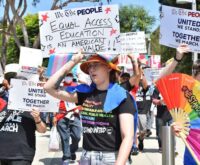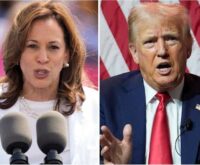A historical overview of one of America’s “most Asian” regionsBy Susie Ling
As an Asian American, I love the San Gabriel Valley. An area with many suburban cities just east of Los Angeles, it’s an Asian Pacific American phenomenon. There are other concentrations of Asian people throughout the United States, but nothing is like the San Gabriel Valley. Of the ten cities in the United States with the highest proportions of Chinese Americans, the first eight are located in the San Gabriel Valley. San Gabriel Valley has attained international fame as a center ofhua qiao or overseas Chinese. But Chinese Americans are in fact a very complex subgroup. More than just being an important Chinese American cultural center, the area is a hub of much broader, multigenerational and multiethnic Asian American diversity, and political and social change. And like its contemporary scene, San Gabriel Valley’s Asian American history is diverse, and complex, but often ignored and misunderstood.
Early Pioneering HistoryPopular folklore holds that real estate agent, Fred Hsieh, began the “first” Asian suburb in Monterey Park in the late 1970s, and that Diho Market was the first modern Chinese supermarket outside of Chinatown. This ignores about one hundred years of history. San Gabriel Valley – like so very much of America’s West – was actually first settled by Chinese, Japanese, Filipino, and South Asian pioneers and settlers in the mid-19th century. The pioneers toiled the fields, picked the grapes and citrus, and built part the infrastructure of today’s San Gabriel Valley. In an article by Edwin Hayes, the agent of the Southern Pacific Railroad depot, he writes:
In 1871, Pasadena had its own Chinese race riot. Unemployed Anglo workers chased the Chinese laundry workers near the corner of Colorado Boulevard and Fair Oaks. Because of the 1882 Chinese Exclusion Act that prohibited further immigration, Chinese workers were stranded in America without their families. The bachelor society dwindled and the need for young cheap laborers would now be fulfilled by Japanese Americans. In the early 20th century, Japanese Americans in the San Gabriel Valley dominated the work in wholesale nurseries, vegetable farms, and fruit stands, but were expected to stay socially segregated. Japanese Americans, perhaps learning from the mistakes of the Chinese, were able to bring picture brides and have children. In El Monte, Japanese American Nisei (2nd generation), along with Mexican elementary children, attended the segregated Lexington School. In San Gabriel City, it was Lincoln School. The Japanese farmers used the labor of their families and other Japanese, Mexican, Filipino and South Asian migrant workers. By the Depression, some Nisei were going to college, becoming more “American.” The internment of all Japanese in California during World War II stopped this trend of economic and social assimilation. In the 1920s and 1930s, Filipino were considered “American nationals” and could immigrate even after the Asian Exclusion Act. There were enough Filipinos to establish an all-male Filipino Club at Pasadena Junior College. Others in this bachelor society worked for hospitals, hotels, restaurants, and farms. Like earlier Chinese and Japanese “school boys”, many Filipinos worked as domestics, cooks, and chauffeurs from Pasadena to El Monte. Asians are certainly not all new immigrants to the San Gabriel Valley; their contributions and history dates back two centuries.
The Post-War PeriodAfter internment, some Japanese Americans – particularly young holders of the G.I. Bill and other prospects – never came back to their birthplace in the San Gabriel Valley. Others came home and reopened their father’s nurseries. Ted Tajima, whose father, Kengo Tajima, was the pastor of the Japanese Union Church of Pasadena (now First Presbyterian Church of Altadena), managed to break the color code and become the first Asian American high school teacher at Alhambra High. He taught English and journalism and was at times referred to as the “Jap teacher.” Shig Kawai came back to the house where he was born after the war. Shig’s carpenter father, Toichiro Kawai, had built that house in Pasadena and the Japanese garden for Henry Huntington. Shig was Jackie Robinson’s teammate in three sports at Pasadena Junior College and part of the California All-Star baseball team of 1936. Shig is bitter that while Robinson and others got to pursue baseball, he was interned for his racial profile. After internment, he began gardening in Pasadena. Later, he built a dental lab and hearing aid company. He still lives in the house his father built. Partly as a result of racial covenants, the proportion of Asian Americans in San Gabriel Valley dropped in the 1950s as new tract homes were sold to migrating Anglos. Malls and freeways displaced the citrus and vegetable farms. By the 1960s, small populations of Japanese, Chinese, and even Filipino Americans persisted in the Valley, but did their best to blend into the dominating “Leave it to Beaver” image. Asians could go to Chinatown or Little Tokyo to shop for specialty foods, attend ethnic churches, or compete in Asian American sports leagues. Pasadena, Temple City, and West Covina did keep active their pre-war Japanese cultural centers. These centers taught Japanese language, kendo, and coordinated community events like obon festivals and New Year mochizuki. Hughes Markets was one the first chains that featured an ethnic section which serviced the Japanese American clientele, especially during New Year’s. A few Asians migrated in during this era. Dr. Annie Siu, born in San Francisco Chinatown, was the first Chinese American woman to attend dental school at UCSF. In 1954, this ABC or “American-born Chinese” moved to Southern California:
It wasn’t always easy but Annie persisted and her successful practice is now managed by her daughter, Dr. Tina Siu. The Sius are active in many community organizations in Alhambra and in the Chinese American community. In 2003, Congress Representative Adam Schiff named Professor Annie Chin Siu as Woman of the Year for California’s 29th District. [citation 3]
In 1960, Alfred Song, a Korean American born in Hawaii, was elected to Monterey Park’s City Council. In 1961, he became the first Asian American elected to the State Legislature when he represented the area in the California State Assembly.
The 1970s-80s: White Flight vs. MulticulturalismLyndon Johnson’s 1965 Immigration Law and international pressures of the Cold War led to a surge of Asian immigrants to the U.S. Los Angeles was the receiving port of much of this new wave. Because of the stipulations in the law, most of the post-1965 immigrants were better educated, urban, upper middle class, and migrating as families units. One significant exception to this general profile were the post-1975 Southeast Asian refugees. By the late 1970s, new Mandarin-speaking immigrant families were purchasing suburban homes in Monterey Park. Realtor Fred Hsieh actively sought to develop what later became called “Little Taipei” or the first suburban Chinatown. Monterey Park was ideal as it is just east of Chinatown and downtown Los Angeles but with a superior public educational system to that of Los Angeles Unified. The Chinese immigrants were also attracted to the suburban lifestyle with newer homes and by the 1980s, condos. One such Chinese commented, “With our limited English skills, we preferred newer homes to avoid the hassle of calling in plumbers, electricians, and the like.” The community was cemented by Diho Market on Atlantic Boulevard that sold fresh Asian produce, Asian meat cuts, and food needs. The Mandarin-speaking – and Latino – population grew steadily in Monterey Park. Lily Lee Chen moved to Monterey Park around 1964. Her father was chancellor of a university in China and then Chair of the Education Committee in Taiwan. Lily came to the U.S. in 1958 to pursue higher education. As a parent, Lily became active with Monterey Park’s Boy Scouts and PTA, which led her to run for City Council in 1982. Concurrently, Monty Manibog, a Filipino American attorney who had been an Olympian in his youth, was also on Monterey Park’s City Council. While Monterey Park received recognition as an “All-American City” with an ethnically mixed City Council, some of the older Whites residents led by Barry Hatch and Fred Arcurci felt more and more threatened. This manifested itself in a grassroots-based slow growth movement protesting the “invasion” of mini-malls, condos, and Asians. In 1986, Lily was replaced by Barry Hatch on the City Council. An overtly racist movement had evolved. Monterey Park voted to have English as the official language of the city. Monterey Park voted to limit non-English business signs. Some residents complained about the lack of “good” restaurants as Chinese restaurants proliferated. [citation 4] Lily recalls:
1990s to 2000: Era of Change, Change, and More ChangeAccording to the 1990 census, Monterey Park had a majority 56 percent Asian population. Inevitably, White flight took place and more Mandarin Chinese – followed by populations of other Asians – started to migrate to the other suburban communities of San Gabriel Valley including Alhambra, San Gabriel, Rosemead, etc. After some initial resistance, public libraries and schools began to embrace multilingualism and multiculturalism. Alhambra High School established Mandarin into their foreign language curriculum. Alhambra Rotary is very ethnically diverse and supports myriad community activities. Since 1991, the City of Alhambra and the City of San Gabriel have jointly sponsored a Lunar New Year parade. Wealthier Chinese, Filipinos, and Koreans were more attracted to San Marino, Arcadia, and South Pasadena. San Marino Unified and Arcadia Unified consistently boast of high national academic achievement levels. After 2000, the two school districts ranged from about 60 to 70 percent Asian students, of which most are Chinese. The parents are typically bankers, lawyers, investors or business-owners; many active in the increasingly important globalization scene. Indeed, the “parachute kids” of San Marino and Arcadia had fathers working in high finance in Asia, mothers who traveled back and forth, and who were often left in the inadequate care of an aunty or friend. “Parachute kids” often drove expensive cars, lived in lonely McMansions, and hung out together at local restaurants or clubs.
The 21st Century: Diversity is NormOf course there are problems in the San Gabriel Valley. Development has led to congestion. Unemployment, homelessness, and drug abuse are real. There are Asian gangs, Latino gangs, and even mixed gangs. There have been racial squabbles at each of the local high schools. Asians are underrepresented in certain professions and overrepresented in certain industries. But for the young generation of San Gabriel residents, diversity is norm. As happily as they embrace new technologies, they accept social change and think it is normal. Multilingual, multiracial, and multicultural, they are comfortable in diversity and they expect diversity. The Asian American youth do not know that they are “supposed to” major in engineering and not in sports. They would not understand why they would want to or “should” date someone of their own ethnic background, as many of their uncles and aunties have mixed marriages. With cultural tolerance is a great celebration of other forms of diversity, from disability, to sexual orientation, to lifestyle. These kids are the Asian American generation that owns the San Gabriel Valley. Enviably, they have no clue that they are supposed to be “aliens” or “foreigners,” or “stick to their own”. Ah Goong, the Issei, and the manongs would be deservedly proud of their legacy. [citation 6]
Notes & Citations
Susie Ling is Associate Professor of Asian American studies at Pasadena City College in the San Gabriel Valley. She also lives in the San Gabriel Valley and is a member of the Chinese Historical Society of Southern California (www.chssc.org). Photos on this page are from “Pre-War San Gabriel Valley Reunion, 1987” pamphlet of the East San Gabriel Valley Japanese Community Center, West Covina, CA, and are used with permission. |
||||||||||||||||||||||||||||||||||||
|











